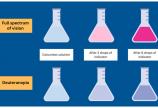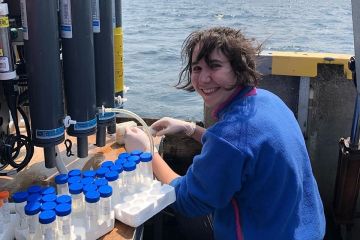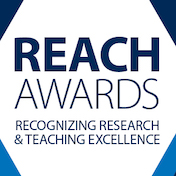Improving accessibility in chemistry education

Chemistry can be a very colourful science. From titrations to chromatography to pH indicators to spectroscopy, colour is often used to measure and analyze substances and chemical processes. While colour can be a great source of information, for the 5-8% of men and 0.5-1% of women with colour vision deficiency (CVD), it can also cause difficulties.
University of Victoria master’s student Nicholas Roberts was recently awarded the Chemical Institute of Canada’s Gilead Early Career Award for Excellence in Equity, Diversity and Inclusion for his research and advocacy on navigating CVD in chemistry. In advance of National Accessability Week, we sat down with him to learn more about the issue, his work, and how we can make chemistry more accessible to all.
Q: How did you get involved in research and advocacy related to CVD and chemistry and why is it important to you?
Nicholas Roberts: This project was started by Dr. Jennifer L. MacDonald (Jenn) and myself while I was an undergraduate student at Dalhousie University. I have a condition called deuteranopia, which means I am missing the cones in my eyes that can perceive the colour green. This makes me ‘red-green colourblind.’
While in my second year, I was hired to teach introductory chemistry as a teaching assistant (TA). Whenever experiments required colour-based observations, I would tell my students that I was going to be at best unhelpful, and at worst useless, with helping them determine colours. Because of this, I frequently talked to Jenn about colour issues in chemistry, which led to me being hired to develop the online version of the course when the pandemic started. Since then, I’ve continued to work with Jenn over the years developing online resources, creating awareness and creating practical solutions for those with CVD.
This project is important to me as accessibility is crucial in education. Not being able to perform a task because you are physically unable to do it isn’t a fair way to be assessed in any circumstance. I think it’s important to develop supports and lessons keeping those who need the most support in mind so that everyone can succeed.
Q: How is colour currently being used in chemistry and why is this a problem?
Nicholas Roberts: I don’t like to frame colour as a problem in chemistry. Chemistry is naturally a very colourful science and I think it’s all the better for it. I’m not here to police people to not use colours, but to encourage them to make conscientious choices about the colours they choose to use.
That being said, there are certainly areas where colour can be problematic in chemistry. Dyes, titrations, pH and even figures and text are all areas where students are expected to be able to see the full spectrum of colour. However, what if you need to make your solution neutral, but can’t see the green of the pH paper to confirm this? What if red and green data points are used on a graph without further labelling? What if the reaction procedure says: “mix until the reaction changes from purple to blue?” All of these are areas where colour becomes problematic for students and supports should be put in place.
Q: What are some of the changes you’ve implemented to help increase accessibility in chemistry for folks with CVD? What actions might you recommend others take?
Nicholas Roberts: We’ve done lots of things to improve colour accessibility for students. We’ve created online modules that allow students to hover over a solution and have a label pop up that lists the colour. For an in-person dye-separation experiment, we’ve created a set of custom unknowns that are CVD friendly and created answer keys for TAs to know how to distribute the unknowns. This answer key was loved by TAs because it also helped them troubleshoot when students made mistakes, highlighting that creating accessible solutions helps everyone in the class, not just those with disabilities. We are currently working on our own custom filter card that improves contrast when trying to view titration experiments. We’ve also published a commentary discussing the efficacy of indicators for those with CVD.
The main thing I want others to take away is that they can improve accessibility in small, meaningful steps. People often get overwhelmed by the swathe of literature or think that they have to put in a ton of work to make their class more accessible, but this isn’t necessarily the case. I’d rather someone make small incremental steps over a long period of time, than try to do it all at once, burn out and never try it again.
Q: Beyond the inaccessibility of colour for those with CVD, are there any other barriers to accessibility in science that you’ve encountered in your work?
Nicholas Roberts: Absolutely. Fume hoods are inaccessible to those with mobility issues, many scientific publications aren’t screen-reader friendly for the blind, lectures often lack sign language translations for the deaf and in general the academic system is particularly unkind to those with mental health issues. These are all accessibility issues that need to be addressed so that people realize that anyone can be a scientist, despite whatever biological condition they may live with.
Q: What’s next for you in this work?
Nicholas Roberts: Currently, I am collaborating on an open educational resource about how to handle colour accessibility in science education more broadly. Many of the strategies we’ve developed are relevant to sciences beyond chemistry and we think that by sharing what we know with a broader scientific community, we’ll see more adoption and recognition of this issue. Aside from that, Jenn and I have some other ideas that I don’t want to spoil early, but I encourage readers to keep an eye out for what we have in store.
Further reading
Interested in accessibility in science? Check out these resources recommended by Roberts:
- The Journal of Chemical Education’s EDIA special issue
- The Nature portfolio ‘Disability inclusion in chemistry’
- CAST’s Universal Design for Learning initiative
Photos
In this story
Keywords: Chemistry, accessibility, diversity, education, award
People: Nicholas Roberts






